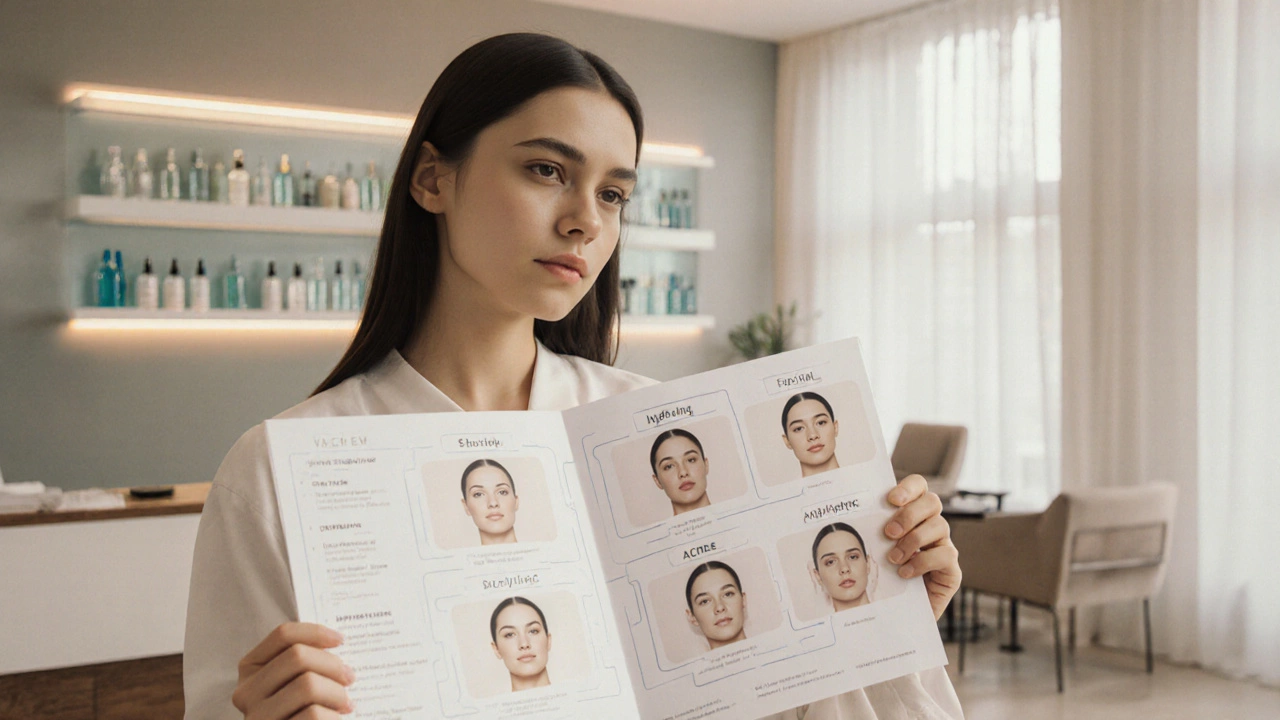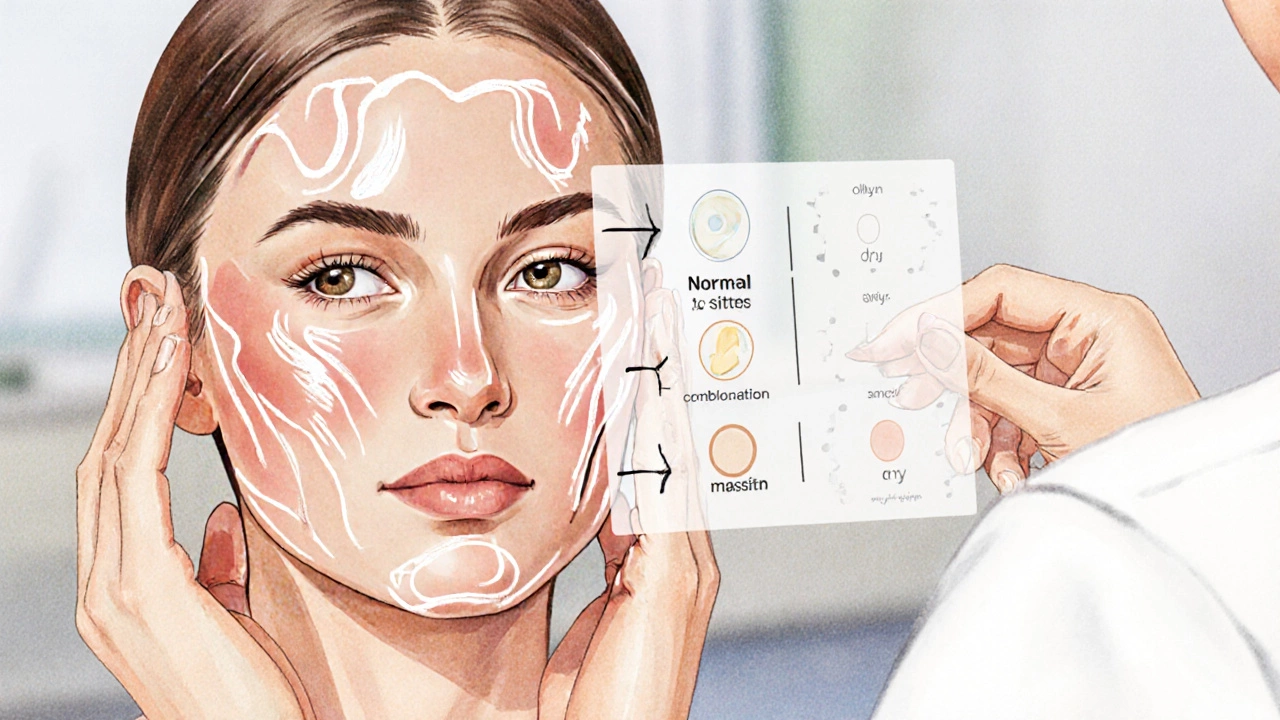Choosing the Right Facial Treatment: A Practical Guide
 Oct, 11 2025
Oct, 11 2025
Key Takeaways
- Know your skin type before booking any facial.
- Match facial goals (hydration, anti‑aging, acne) with the right treatment.
- Check ingredient sensitivities and therapist credentials.
- Use a simple checklist to compare options quickly.
- Follow post‑facial care tips to lock in results.
Choosing the right facial treatment can feel like a maze of buzzwords and price tags. Yet the decision boils down to three basics: who you are, what you want, and how a professional can deliver it safely. Below you’ll find a step‑by‑step framework that turns vague marketing copy into a clear, personalized plan.
Facial treatment is a skin‑care service that combines cleansing, exfoliation, massage and targeted serums to address specific concerns. It ranges from a quick 30‑minute classic cleanse to a multi‑step anti‑aging protocol that may include LED light therapy. Because the market offers everything from spa‑luxury experiences to at‑home kits, knowing where you fit is the first move.Understanding Your Skin Type
Skin type is a categorization of how your skin behaves under everyday conditions, defined by oil production, moisture retention and barrier strength. The four main categories are normal, oily, dry and combination, with a fifth-sensitive-that cuts across the others. Determining yours is simple:- Wash your face with a gentle cleanser and wait an hour.
- Pat dry and examine the T‑zone (forehead and nose) and cheeks.
- If the T‑zone shines but cheeks feel comfortable, you’re likely combination. If everything feels tight, you’re dry. Persistent shine indicates oily, and any redness or sting suggests sensitive.
Common Facial Types Explained
Below are the most popular facial categories you’ll encounter in a salon or clinic. Each description includes the core steps, ideal skin concerns, and any special equipment.- Classic Cleanse: Focuses on deep cleansing and light exfoliation. Ideal for maintenance and those new to facials.
- Hydrating Facial: Uses hyaluronic‑acid serums and moist masks to boost skin moisture. Best for dry or mature skin.
- Anti‑Aging Facial: Incorporates antioxidants, retinol or peptide‑rich creams, often paired with micro‑current or LED therapy. Targets fine lines and loss of firmness.
- Acne‑Focused Facial: Centers on acne‑prone skin skin that regularly develops inflammatory blemishes and clogged pores. Includes salicylic‑acid exfoliation, extractions, and antibacterial masks.
- Sensitive Skin Facial: Avoids strong acids and fragrances. Uses soothing ingredients like oatmeal, aloe and chamomile.
- Deep‑Cleansing Facial: Employs steam, extractions, and charcoal or clay masks to pull out impurities from congested pores.
- Chemical Peel: Applies a controlled concentration of glycolic or lactic acid to slough off dead cells. Usually reserved for experienced clients seeking a dramatic texture boost.

Matching Facial to Your Goals
Think of a facial as a prescription. The doctor-your aesthetic therapist-needs three pieces of information:- Your skin type (from the earlier section).
- Your primary concern-whether it’s dehydration, wrinkles, breakouts, or redness.
- Any sensitivities or allergies (e.g., fragrance, retinoids).
| Goal | Best Facial Type | Key Ingredient |
|---|---|---|
| Boost moisture | Hydrating Facial | Hyaluronic Acid |
| Reduce fine lines | Anti‑Aging Facial | Peptides & Vitamin C |
| Clear breakouts | Acne‑Focused Facial | Salicylic Acid |
| Soothe redness | Sensitive Skin Facial | Aloe & Chamomile |
| Deep pore detox | Deep‑Cleansing Facial | Charcoal or Clay |
Decision Checklist
Before you book, run through this quick list:- Did you identify your exact skin type?
- Does the facial target your main concern?
- Are the active ingredients compatible with any known sensitivities?
- Is the therapist certified and experienced with your chosen facial?
- Do you understand the post‑facial care routine (products, sun protection, downtime)?
- Is the price transparent? (Ask about add‑ons like extra extractions.)
Comparison of Popular Facial Types
| Facial Type | Best For | Core Steps | Typical Cost (NZD) |
|---|---|---|---|
| Classic Cleanse | Maintenance, all skin types | Cleansing → Light exfoliation → Moisturizer | 45‑70 |
| Hydrating Facial | Dry, mature, combo‑dry areas | Cleansing → Hyaluronic‑acid serum → Sheet mask | 70‑100 |
| Anti‑Aging Facial | Fine lines, loss of elasticity | Cleansing → Antioxidant serum → Micro‑current → Peptide mask | 100‑150 |
| Acne‑Focused Facial | Active breakouts, oily zones | Cleansing → Salicylic‑acid peel → Extraction → Antibacterial mask | 80‑120 |
| Sensitive Skin Facial | Redness, easily irritated skin | Cleansing → Soothing serum → Oatmeal mask → Calming cream | 70‑110 |
| Deep‑Cleansing Facial | Congested pores, blackheads | Steam → Clay mask → Extraction → Cooling toner | 90‑130 |
| Chemical Peel (light) | Texture, mild hyperpigmentation | Pre‑peel cleanse → Glycolic‑acid solution → Neutralizer → Moisturizer | 120‑180 |

Pro Tips & Common Pitfalls
- Patch test first. Ask for a small sample of any active serum, especially if you have sensitive skin skin that reacts to strong ingredients with redness or burning.
- Don’t skip post‑facial sunscreen. Even a hydrating mask leaves your skin more photosensitive for 24‑48 hours.
- Avoid over‑exfoliating. Two strong exfoliation steps in one session can damage the barrier, leading to increased oil production.
- Ask about the therapist’s training formal education in aesthetic procedures and safety protocols. Certified staff reduce the risk of infection during extractions.
- Consider frequency. Most facials deliver optimal results when spaced 4‑6 weeks apart, giving skin time to rebuild.
Frequently Asked Questions
Frequently Asked Questions
How often should I get a facial?
For most skin types, a 4‑to‑6‑week interval balances results and recovery. If you have acne‑prone skin, a shorter 2‑week schedule may be advised by a dermatologist, but watch for irritation.
Can I combine two facial types in one session?
Mixing strong actives-like a chemical peel with an aggressive acne extraction-can overwhelm the skin barrier. It’s safer to pick one primary goal per visit and schedule a complementary facial later.
What should I avoid after a facial?
Skip hot showers, intense workouts, and direct sun exposure for at least 24 hours. Also steer clear of retinol or strong acids for 2‑3 days unless your therapist says otherwise.
Is it worth paying extra for a ‘luxury’ facial?
Luxury often adds ambiance, higher‑end ingredients, and longer session time. If those extras align with your skin goals-like a premium peptide cocktail-they can be valuable. Otherwise, a well‑executed standard facial delivers comparable results for less.
Do I need a prescription for a chemical peel?
Mild peels (up to 30% glycolic acid) are generally safe over the counter, but a professional assessment ensures the strength matches your skin tolerance. Stronger peels usually require a dermatologist’s supervision.
Armed with this framework, you can walk into any spa, clinic, or boutique and pick a facial that truly fits your skin’s story. Remember, the best treatment is the one that respects your unique needs while delivering visible, lasting benefits.
